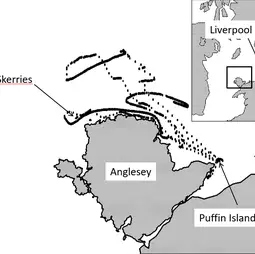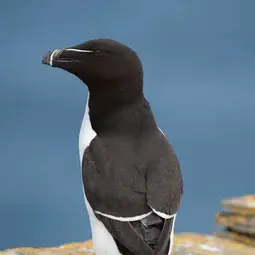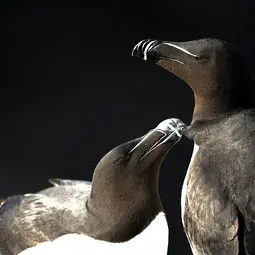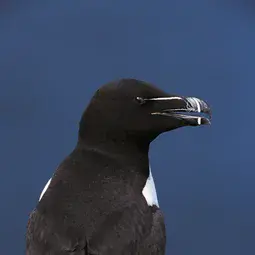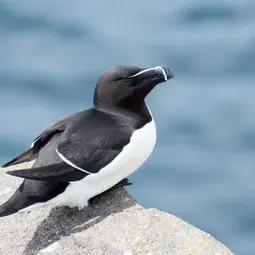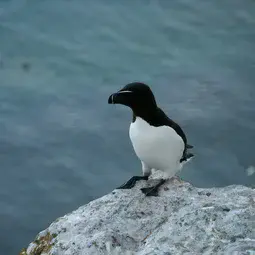What seabirds can tell us about the tide
When the UK’s Royal Society for the Protection of Birds (RSPB) set out to tag razorbills, their aim was to track their behaviour and movements along the coast of North Wales. The tag data revealed that, at night, these seabirds spent a lot of their time idle on the sea surface. “We saw this as an opportunity to re-use the data and test if the birds might be drifting with the tidal current,” says Matt Cooper, a Master of Oceanography graduate from Bangor University in Wales. It turns out they were, according to a new study led by Cooper that shows the potential of using seabirds to measure ocean currents. The results are published today in the European Geosciences Union journal Ocean Science.
Using seabirds to tell us about the tide could be especially useful for the marine renewable energy industry. Generating tidal energy requires detailed knowledge of current speeds. Scientists and engineers traditionally measure tides by using radar or deploying anchors and buoys with scientific instruments. However, these scouting methods are challenging and expensive. If tagged seabirds could provide tidal data over a large area, they could help identify sites that would be good sources of tidal energy.
Cooper’s supervisors at Bangor University knew of his interest in tidal energy and data collection, so they suggested he look into seabird data collected by the RSPB to see whether it would be possible to extract tidal information from it. A few years earlier, from 2011 to 2014, a RSPB team had fitted GPS tags on razorbills on Puffin Island, North Wales, to study their distribution and breeding and feeding behaviours. These black and white seabirds, similar to puffins and guillemots, only come ashore to breed. They spend most of their time at sea, foraging or resting on the ocean surface.
The data collected when the birds were sitting on the sea surface for hours on end were interesting in terms of bird behaviour, but the Bangor University researchers saw another potential use. “We took data that was discarded from the original study and applied it to test a hypothesis in a different area of research,” says Cooper. “As far as we are aware, this paper is the first to describe the use of tagged seabirds for measuring currents of any kind,” the researchers write in their Ocean Science study.
The non-invasive GPS tags on the razorbills recorded their position every 100 seconds. With a set of positions and a known time between each of them, the scientists could calculate the speed and direction of the birds’ movements. After the sun set, the birds spent long periods at rest on the sea surface, drifting passively with the current. “[At these times] their changing position would reflect the movement of water at the ocean’s surface,” Cooper explains.
With speeds of more than 1 metre per second, the average tidal currents in the area of the Irish Sea the researchers focused on are very fast, faster than a razorbill can paddle, but much slower than the speeds the birds reach when flying. This means the team could filter out the times when the birds were flying. In addition, the filtered data showed that, when the birds were drifting, the direction of movement changed at the times of low and high tide, when the currents in the area were expected to change from ebb to flow and vice-versa. Therefore, the team could be sure that they were tracking the speed and direction of sea currents rather than the birds’ independent movements.
Using seabirds to measure tidal currents has limitations. “We must remember that these birds are behaving naturally and we cannot determine where they go,” says Cooper. But the Ocean Science study shows there is potential for this inexpensive method to provide crucial tidal information over a wide area. By studying other tagged seabirds, we could learn more about our oceans, especially in more remote regions where it is challenging to collect oceanographic data.
Cooper also hopes the method can reduce the costs of generating tidal renewable energy, “which has been a barrier to the development of this much needed industry.”
###
Please mention the name of the publication (Ocean Science) if reporting on this story and, if reporting online, include a link to the paper (https://www.ocean-sci.net/14/1483/2018/) or to the journal website (https://www.ocean-science.net).
More information
This is a co-release with the Royal Society for the Protection of Birds and Bangor University. The research is presented in the paper ‘What can seabirds tell us about the tide?’ published in the EGU open access journal Ocean Science on 29 November 2018 at https://www.ocean-sci.net/14/1483/2018/.
Citation: Cooper, M., Bishop, C., Lewis, M., Bowers, D., Bolton, M., Owen, E., and Dodd, S.: What can seabirds tell us about the tide?, Ocean Sci., 14, 1483-1490, https://doi.org/10.5194/os-14-1483-2018, 2018.
The study was conducted by Matthew Cooper (School of Ocean Sciences, Bangor University, Wales, UK [Oceans Sciences, Bangor]), Charles Bishop (School of Biological Sciences, Bangor University, Wales, UK), Matthew Lewis (Oceans Sciences, Bangor), David Bowers (Oceans Sciences, Bangor), Mark Bolton (RSPB Centre for Conservation Science, Bedfordshire, UK), Ellie Owen (RSPB Centre for Conservation Science, RSPB Scotland, Inverness, UK) and Stephen Dodd (RSPB, unit 14 Llys Castan, Ffordd y Parc, Bangor, UK).
The European Geosciences Union (EGU) is Europe’s premier geosciences union, dedicated to the pursuit of excellence in the Earth, planetary, and space sciences for the benefit of humanity, worldwide. It is a non-profit interdisciplinary learned association of scientists founded in 2002 with headquarters in Munich, Germany. The EGU publishes a number of diverse scientific journals, which use an innovative open access format, and organises a number of topical meetings, and education and outreach activities. Its annual General Assembly is the largest and most prominent European geosciences event, attracting over 14,000 scientists from all over the world. The meeting’s sessions cover a wide range of topics, including volcanology, planetary exploration, the Earth’s internal structure and atmosphere, climate, energy, and resources. The next EGU General Assembly is taking place in Vienna, Austria, from 7 to 12 April 2019. For more information and press registration, please check https://www.egu.eu/gamedia, or follow the EGU on Twitter and Facebook.
If you wish to receive our press releases via email, please use the Press Release Subscription Form at http://www.egu.eu/news/subscribe/. Subscribed journalists and other members of the media receive EGU press releases under embargo (if applicable) at least 24 hours in advance of public dissemination.
Ocean Science (OS) is an international open-access scientific journal dedicated to the publication and discussion of research articles, short communications, and review papers on all aspects of ocean science: experimental, theoretical, and laboratory. The primary objective is to publish a very high-quality scientific journal with free Internet-based access for researchers and other interested people throughout the world.
The Royal Society for the Protection of Birds (RSPB) is the UK’s largest nature conservation charity, inspiring everyone to give nature a home. Together with their partners, they protect threatened birds and wildlife so the UK’s towns, coast and countryside will teem with life once again. They play a leading role in BirdLife International, a worldwide partnership of nature conservation organisations. The Royal Society for the Protection of Birds (RSPB) is a registered charity: England and Wales no. 207076, Scotland no. SC037654.
Bangor University has a long record of academic excellence and a reputation for excellent teaching and student care. The University has 11,000 students and offers 500 degree programmes, with particular strengths in the fields of Environmental Science (including Ocean Sciences). The School of Ocean Sciences is one of the largest multi-disciplinary centres teaching Marine Sciences in Britain and is among the biggest in Europe. It is also a leading international research institution, with well-resourced groups working across the boundaries of the principal disciplines of biology, chemistry, geology and physics. Visit the University website at: www.bangor.ac.uk.
Contact
Researchers
Matt Cooper
Master of Oceanography graduate, Bangor University, Wales, UK
Phone +44-(0)78-100-808-26
Email mczakk@hotmail.com
Press officers
Bárbara Ferreira
EGU Media and Communications Manager
Munich, Germany
Phone +49-89-2180-6703
Email media@egu.eu
Twitter: @EuroGeosciences
Elinor Elis-Williams
Press Officer at Bangor University
Bangor, Wales, UK
Phone +44(0)1248 383298
Email e.elis-williams@bangor.ac.uk
Twitter: @BangorUni
Vanessa Amaral-Rogers
Consumer PR Executive at RSPB
Email vanessa.amaralrogers@rspb.org.uk
Twitter: @Natures_Voice
Danny Griffith
Communications Officer at RSPB Cymru
Bangor, Wales
Email danny.griffith@rspb.org.uk
Links
- Scientific paper
- Journal – Ocean Science
- Read this press release in simplified language, aimed at 7–13 year olds, on our Planet Press site


